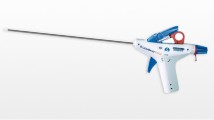Abstract
Introduction
Uncoated, lightweight, macroporous, monofilament mesh has been shown to demonstrate improved bacterial clearance, better tissue integration, reduced foreign body response, and less chronic pain with equivalent durability for hernia repair. These findings led us to use a new lightweight monofilament polyester mesh (Parietex TCM, Covidien). Here, we report our experience with this mesh in open incisional hernia repair.
Methods
Patients undergoing incisional hernia repair with Parietex TCM were retrospectively identified within our prospectively maintained database. Patient demographics, operative characteristics, and follow-up were reviewed. Outcome parameters included 90-day wound morbidity and hernia recurrence.
Results
In 2011, 36 patients (mean age 56.8; mean BMI 32.4 kg/m2) underwent open incisional hernia repair with retrorectus mesh placement by two surgeons (MJR, YWN) at Case Medical Center. Anterior and posterior fascial closure was achieved in all cases. Wound morbidity included seven surgical site occurrences: four superficial infections that resolved with antibiotics, one wound dehiscence requiring wet-to-dry packing, and two seromas that resolved without intervention. With a mean follow-up of 13 months, 8 (22 %) recurrences have occurred. On reoperation, 7 (19 %) of these patients had mechanical failure or fracturing of the mesh. No confounding variables were identified by univariate analysis of patient demographics, operative characteristics, or wound morbidity.
Conclusion
Lightweight monofilament polyester mesh (Parietex TCM) appears to have a high incidence of mechanical failure in the context of open incisional hernia repair. While this limitation may ultimately be revealed as a weakness of all lightweight mesh, surgeons should be aware that these failures have already been documented.
Similar content being viewed by others
References
Luijendijk RW et al (2000) A comparison of suture repair with mesh repair for incisional hernia. N Engl J Med 343(6):392–398
Burger JW et al (2004) Long-term follow-up of a randomized controlled trial of suture versus mesh repair of incisional hernia. Ann Surg 240(4):578–583 discussion 583–585
Nguyen PT, Asarias JR, Pierce LM (2012) Influence of a new monofilament polyester mesh on inflammation and matrix remodeling. J Invest Surg 25(5):330–339
Asarias JR et al (2011) Influence of mesh materials on the expression of mediators involved in wound healing. J Invest Surg 24(2):87–98
Sanders D, Lambie J, Bond P, Moate R, Steer JA (2013) An in vitro study assessing the effect of mesh morphology and suture fixation on bacterial adherence. Hernia 17(6):779–789
Blatnik JA et al (2012) In vivo analysis of the morphologic characteristics of synthetic mesh to resist MRSA adherence. J Gastrointest Surg 16(11):2139–2144
Bryan N et al (2012) In vitro activation of human leukocytes in response to contact with synthetic hernia meshes. Clin Biochem 45(9):672–676
Orenstein SB et al (2012) Comparative analysis of histopathologic effects of synthetic meshes based on material, weight, and pore size in mice. J Surg Res 176(2):423–429
Schmidbauer S et al (2005) Heavy-weight versus low-weight polypropylene meshes for open sublay mesh repair of incisional hernia. Eur J Med Res 10(6):247–253
Cobb WS et al (2006) Textile analysis of heavy weight, mid-weight, and light weight polypropylene mesh in a porcine ventral hernia model. J Surg Res 136(1):1–7
Cobb WS, Kercher KW, Heniford BT (2005) The argument for lightweight polypropylene mesh in hernia repair. Surg Innov 12(1):63–69
Novitsky YW et al (2012) Transversus abdominis muscle release: a novel approach to posterior component separation during complex abdominal wall reconstruction. Am J Surg 204(5):709–716
Zuvela M, Galun D, Djuric-Stefanovic A, Palibrk I, Petrovic M, Milicevic M (2014) Central rupture and bulging of low-weight polypropylene mesh following recurrent incisional sublay hernioplasty. Hernia 18(1):135–140
Ray JA et al (1981) Polydioxanone (PDS), a novel monofilament synthetic absorbable suture. Surg Gynecol Obstet 153(4):497–507
Shumacker BH Jr, Mandelbaum I (1961) Clinical evaluation of dacron suture material. Arch Surg 83:647–649
Conflict of interest
CP declares no conflict of interest.
EH declares no conflict of interest.
CC declares no conflict of interest.
SO declares no conflict of interest.
HV declares no conflict of interest.
YN declares conflict of interest––paid consultant for LifeCell and C. R. Bard––not directly related to the submitted work.
MR declares conflict of interest––Paid consultant for LifeCell and C. R. Bard. Research grant from Gore.––not directly related to the submitted work.
Author information
Authors and Affiliations
Corresponding author
Rights and permissions
About this article
Cite this article
Petro, C.C., Nahabet, E.H., Criss, C.N. et al. Central failures of lightweight monofilament polyester mesh causing hernia recurrence: a cautionary note. Hernia 19, 155–159 (2015). https://doi.org/10.1007/s10029-014-1237-5
Received:
Accepted:
Published:
Issue Date:
DOI: https://doi.org/10.1007/s10029-014-1237-5




